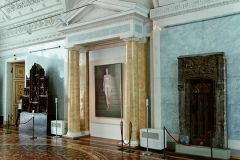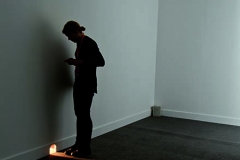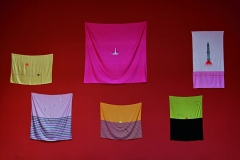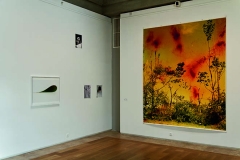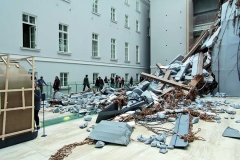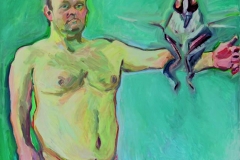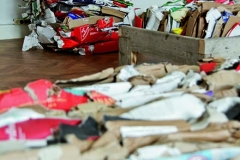A green VAZ-2101 (or Lada 1200 as it was marketed in the West, nicknamed the Kopeyka), crashed into a tree in the courtyard of the St Petersburg Hermitage museum, stood as an iconic entrance work to the European contemporary art biennale Manifesta 10 exhibitions, which opened at the end of June. The piece, conceived by Francis Alÿs, represented a paradoxical fulfilment of the artist’s youth-time dream of driving his car from Belgium to the Soviet Union, to a country that in the Cold-War capitalist West represented “the alternative way, the Cause, the Call-all that our parents feared”, as the artist put it. Making this trip a reality only over twenty years after the demise of the Soviet Union, this original meaning had now been ironically over-turned, and the video installation inside the exhibition space focused on the final moments of the journey: a crash, signalling failed utopias of socialism and dreams that never materialised. But the piece was also telling in terms of the projections of the Western left of the Soviet Union as an other to the capitalist system, a long-time tradition that seldom has received critical exploration and whose ghost still seems to haunt much of the interaction with today’s Russia. To an historian’s eye, this work has additional meanings: the Lada car was manufactured in the Soviet town of Togliatti beginning in 1970, under a licence from the Italian car manufacturer Fiat, demonstrating a turn that started in the late 1960s, away from the self-sufficiency of state socialism towards a greater integration with capitalist economies and their forms of consumption. Thus, while for the critical left in the West the Soviet Union represented an other to capitalism, the Soviet Union of the 1960s and 1970s demonstrated an ever-growing desire to copy life in the West and achieve similar standards.
Many of these diverging expectations surfaced and converged, either intentionally or unwittingly, in other parts of the biennale and its numerous parallel programmes in the city of St Petersburg. The event attracted criticism and generated polemics internationally long before its opening: initially the curator Kasper König had to respond to calls for a boycott by international LGBT activists protesting against severe anti-gay laws in Russia; things took an even more dramatic turn with the Russian invasion of Crimea and its subsequent annexation in March 2014, leading to the withdrawal of some artists. On the other side, the organisers had to deal with impenetrable Russian bureaucracy and a different kind of work culture, as well as the institution of the Hermitage, not accustomed to contemporary art and its tendency to upset traditions and hierarchies. The green Lada was one in a series of carefully – thoughtfully as well as cautiously – managed interventions in the show, aiming to shift or displace the perceived meanings of places and museum works, thus bringing forth previously marginalised meanings or new connections. In the case of the car, the Winter Palace was also the symbolic site of the beginning of the October Revolution, and now this was brought together with its failure, evoking perhaps some surprise among its middle-class visitors. Would eyebrows be raised at a crashed Lada in a courtyard of a prefabricated modernist neigbourhood in a St Petersburg suburb, where ‘really existing socialism’ left its strongest imprint?
Thomas Hirschhorn, well-versed in working with the ruins of both socialism and modernity, who had turned to peripheral territories in the past, this time had chosen to intervene in the somewhat pompous newly renovated series of courtyards of the General Staff building, the main venue for the curator show. His site-specific installation Abschlag was a mock-up of a crumbling wall of a neoclassical structure, revealing behind it ordinary apartments with now-precious avant-garde artworks on their walls. Hirschhorn’s strategy in earlier works had been to uncover ‘minor’ figures in the culture of the hosting environment, thus deconstructing perceived canons of value and putting them to work for new ends. Here the works of Malevich, Filonov and Rozanova, could then be read in the same way, as attempts to tear them off from the depoliticised context and reactivate the original coexistence of new aesthetics with radical political ideas. In addition, the installation proposed to overturn the powerful architectural context, but perhaps its size started at some point to work against its aims, leaving the apartments too distant from the viewer and neutralising the deconstructive gesture.
From that perspective, Erik van Lieshout’s displacement of the Hermitage cellar to the exhibition hall was more successful, operating on many levels. The installation focused on cats living in the basement of this huge museum complex; the cats had been brought in during the czarist era to hunt mice and rats. With the Soviet Union, and later the post-Soviet years, the status of the cats, now looked after by museum workers, became precarious. During preparations for Manifesta, in the basement Lieshout created new living conditions for the cats and put up a small exhibition. The viewers were shown documentation and preparatory sketches of the work and the installation managed to conquer the copious space in simple but convincing ways (among other things, hinting at a parallel between the monumental doors of the General Staff courtyards and the gilded Kremlin doors). The work was also one in a series that could be seen as referencing the punk-band Pussy Riot, demonstrating in this way a return to the infamous late-Soviet artistic strategy of Aesopian language: conveying a ‘hidden’ message through a seemingly neutral surface. If this artistic strategy is actually showing signs of returning, that raises worries both in terms of a diagnosis of society and the fate of critical artistic practice. Lieshout’s reference to the oppositional music group was ephemeral, but it appeared as manifestly attached to the re-staged installation of Juan Muñoz’s Waiting for Jerry (the mouse in the cartoon Tom and Jerry). In Oliver Mosset’s monochrome paintings, on the other hand, the reference of bright hues to the similarly coloured clothing items of the Pussy Riot members required extra information to be understood.
A series of artworks in the main exhibition dealt with disciplining and training the body, as in classical ballet or gymnastics, as seen in the cleverly contextual works of Rineke Dijkstra and Klara Lidén. These can be connected with views of the unbound body through more traditional media, from Henri Matisse’s Dance, which was included in the show from the Hermitage’s permanent collection, to Gerhard Richter’s Ema (Nude on a Staircase). Other works, more directly commenting on the anti-gay laws, revealed different trajectories and means of bodily expression, representing queerness in intimate aesthetic details (as in Wolfgang Tillmans’s installation) or in a charade and parody intersecting with politics: Henrik Olesen‘s Hysterical men depicted, among others, Chelsea Manning, the former US soldier Bradley Manning, who passed on secret information to Wikileaks and later in prison announced his plans for a gender change. In the same series, there were video works by Vladislav Mamyshev-Monroe, a Russian artist who died tragically last year, and who had been active from perestroika onwards in a group of radical Leningrad artists gathered around Timur Novikov. Accoring to Mamyshev, he first became attached to the figure of Marilyn Monroe when his high-school teacher told her class the tragic life story of the American actress. Mamyshev became a Marilyn impersonator, re-acting in amateur films several famous episodes from the star’s life (e.g. her affair with John Kennedy). Many trajectories come together in his works: the eccentricity of provincial Leningrad in the 1980s, Soviet-period interpretations of icons of American mass culture, and the successful career of the artist in the liberal post-socialist period and the bitter recognition that this moment had passed, while the works themselves still continued to have a bite.
In the Hermitage building, across the Palace square, Maria Lassnig’s works represented a dialogue with the bodies and drags in the General Staff. An Austrian painter who passed away this year at the age of 94, her works deal with images of the ageing body, the body torn up to reflect psychic disturbances, violence often represented in a grotesque way. But perhaps most telling in her exposition was the short film Cantata, from 1992, where she sings her life story in laconic verse yet in an amusing way, dressed in various costumes to parody the cultures and people she has encountered. Her message was that art had helped her overcome the difficulties of personal life and social circumstances: “I know its Art so dear that keeps me young and clear.”
‟Art made me thirsty, now fulfilment’s near”, goes the refrain. This humorous yet melancholic film gains a broader relevance in the context of Manifesta: after the Russian invasion of Ukraine, the organisers had to take a stand on whether to continue with preparations for the exhibition and announced their decision in a public statement. Their solution was a kind of ‘criticism from within’: to try to follow the laws and regulations of the hosting country and hosting museum, but maintain standards that would satisfy the politically-oriented contemporary art world. For the St Petersburg radical art group Chto Delat, this position was too collaborative and they withdrew from the show and issued a public statement pointing out, among other things, that Manifesta’s and its curator’s decision showed the clear prevalence of ‘art over politics’. Two weeks before the opening, Kasper König himself seemed to reverse his previous views, giving a critical interview to Deutsche Welle in which he told how the preparations of the biennale had hit an impasse and that he was working in a context where there was no public discussion tradition as in the West: “I think it’s unfortunate that things are trivialised and there is no conflict. Conflict would actually be very positive because it could lead to change.” One couldn’t help then reading into Lassnig’s bitter statement at the end of her life, of ‘art so dear’, a clandestine curatorial declaration, or perhaps even a withdrawal. (The lack of status of Manifesta in St Petersburg was clearly demonstrated by the fact that, on the public opening day of the show, the Palace square, from where both main venues could be entered, was taken over by sports events of the ‘day of youth’ and access to the museums was nearly impossible.)
There were some directly political works in the main show. Boris Mikhailov’s series of photographs documented daily life on Maidan Nezalezhnosti during the uprising in Kiev in December 2013: people coming together in the hope of change and a better future. The presence of these works in the Hermitage was significant, and indeed on the second specialist preview day offensive comments had been added by local viewers to the labels on the artworks. The many Ukrainian flags shown in the photographs suddenly started to resonate with Timur Novikov’s flags from the 1980s downstairs. Created when the Soviet Union was already disintegrating, these flags depicted imaginative combinations of flowery patterns, unexpected colours, silhouettes of swans, palm trees and pyramids, images not normally associated with standard flags. These images could be read as a dream of a better society – which could live under these kinds of flags – but they also signified a moment of fragmentation of supposedly universally held truths and the rise of new smaller states with their own symbols, imagery and aspirations. Now, when flags, ribbons and lintels were out in the streets and were significant again, these two historical moments met up, recalling energies and hopes that could not simply be suppressed by manipulations from above or endlessly kept in check by force.
Manifesta, the European Biennial of Contemporary art and culture that changes location every two years. Manifesta began as a Dutch initiative to create a pan-European platform for the contemporary visual arts. Manifesta 10 took place in St Petersburg from 28 June to 31 October 2014.


